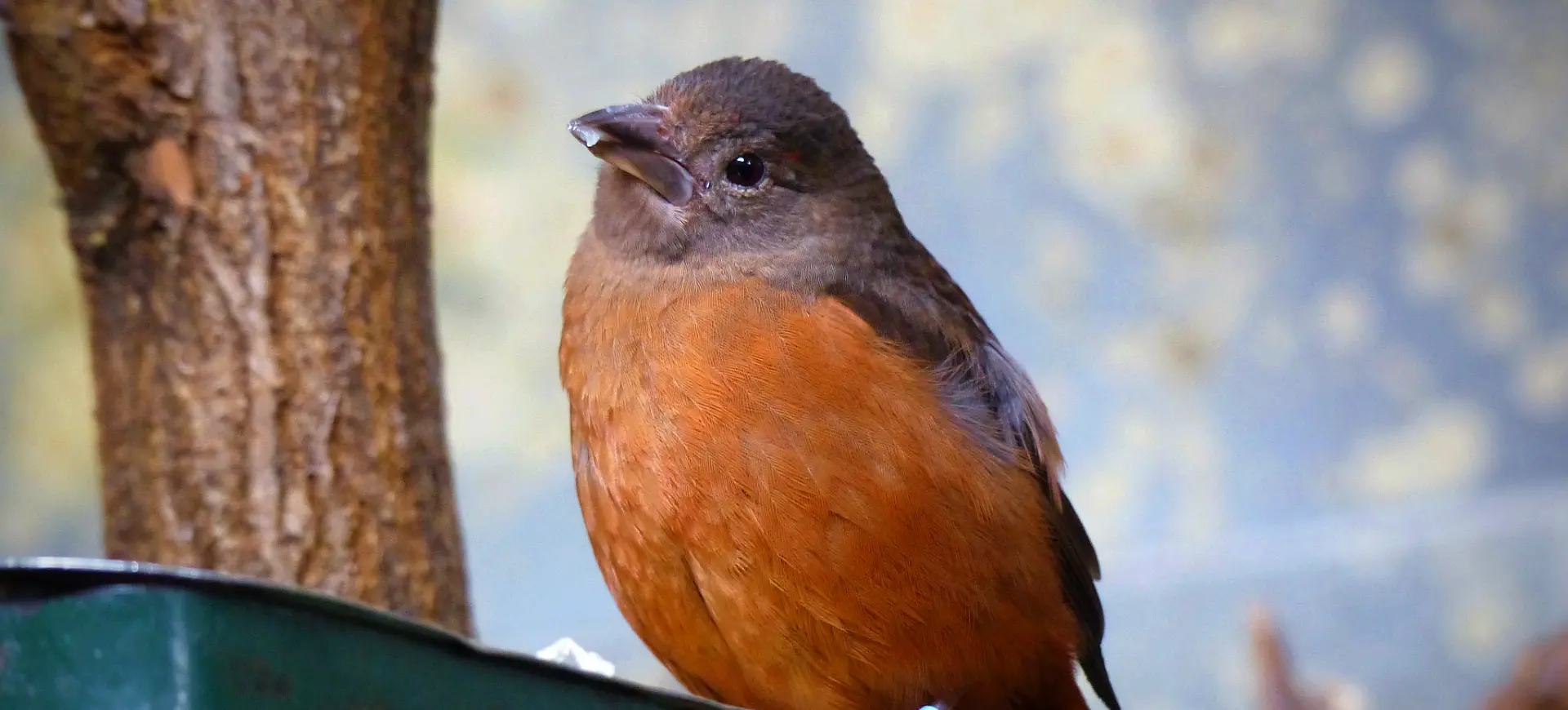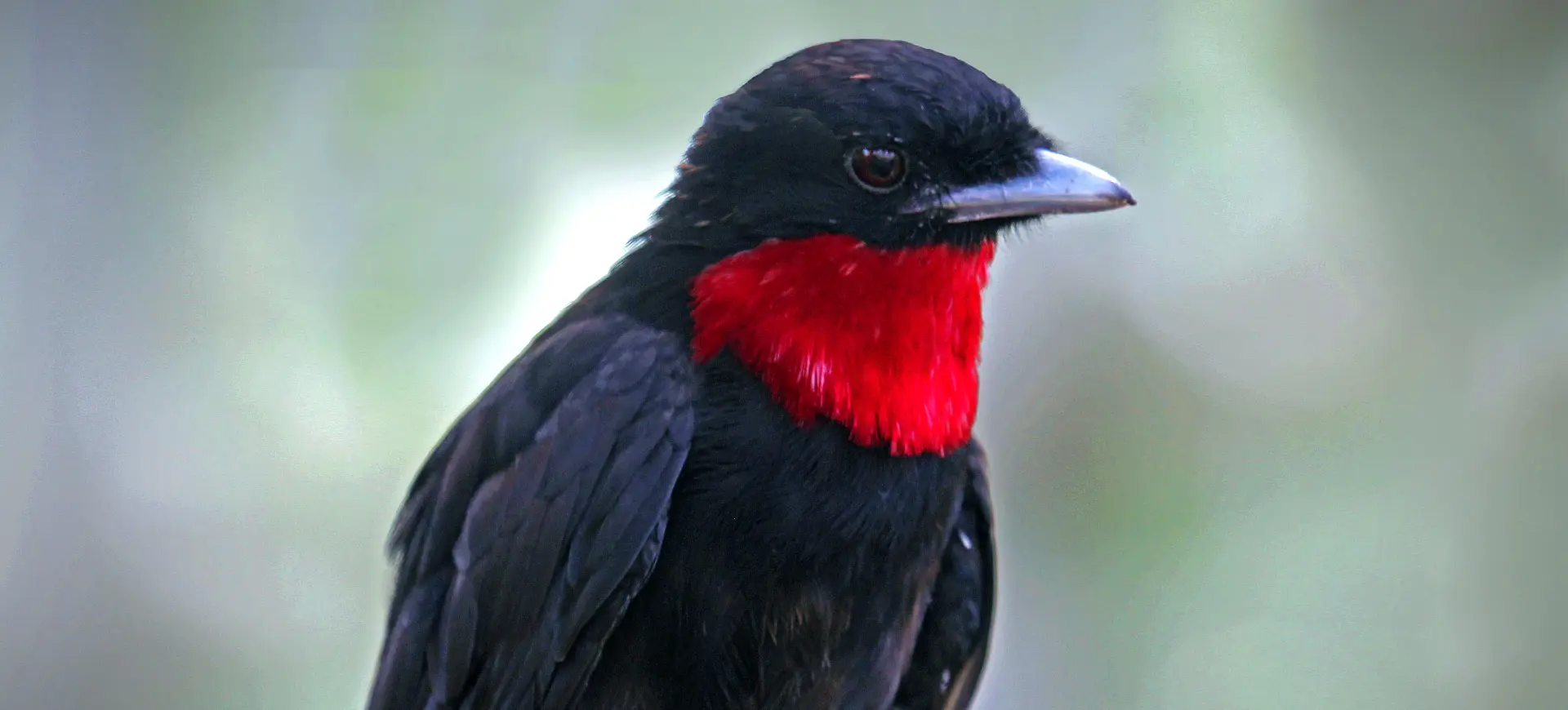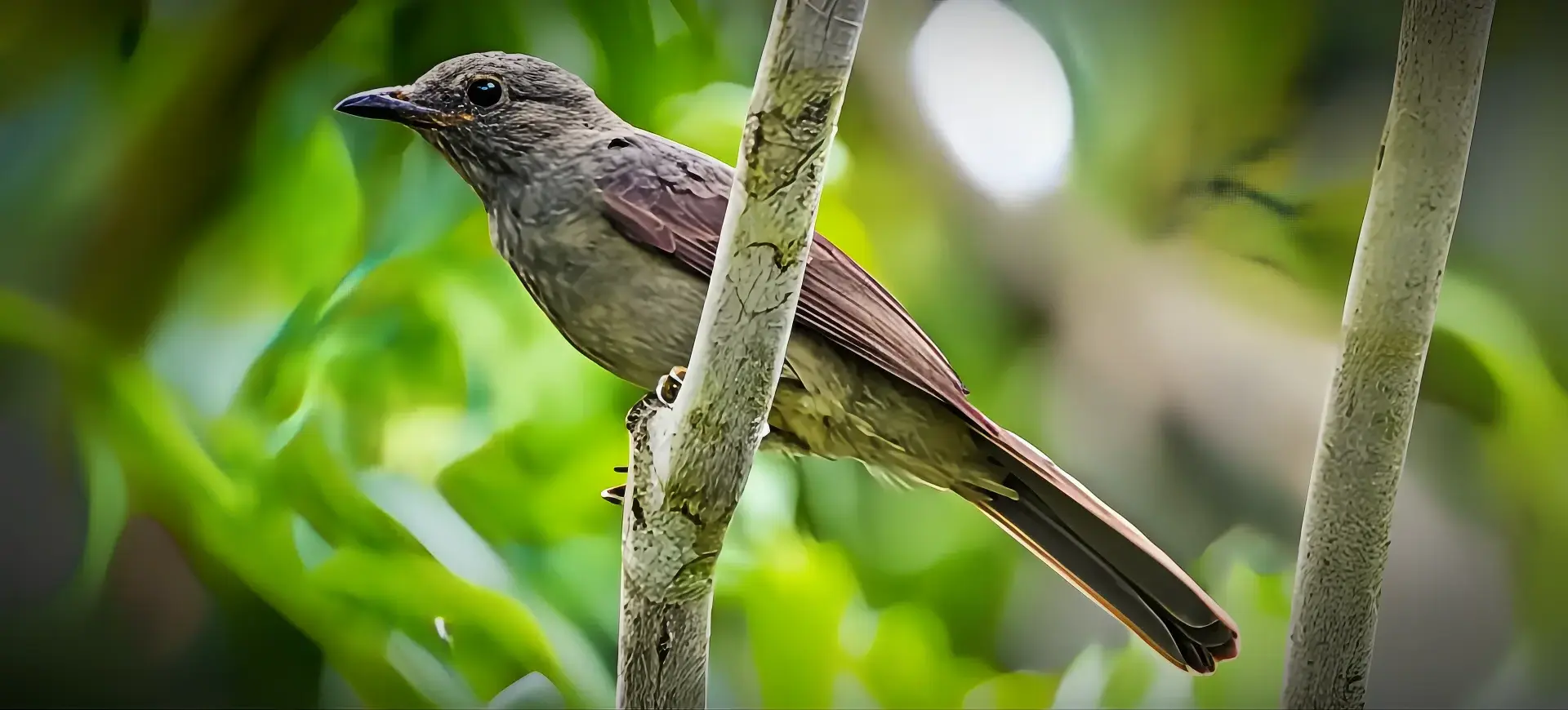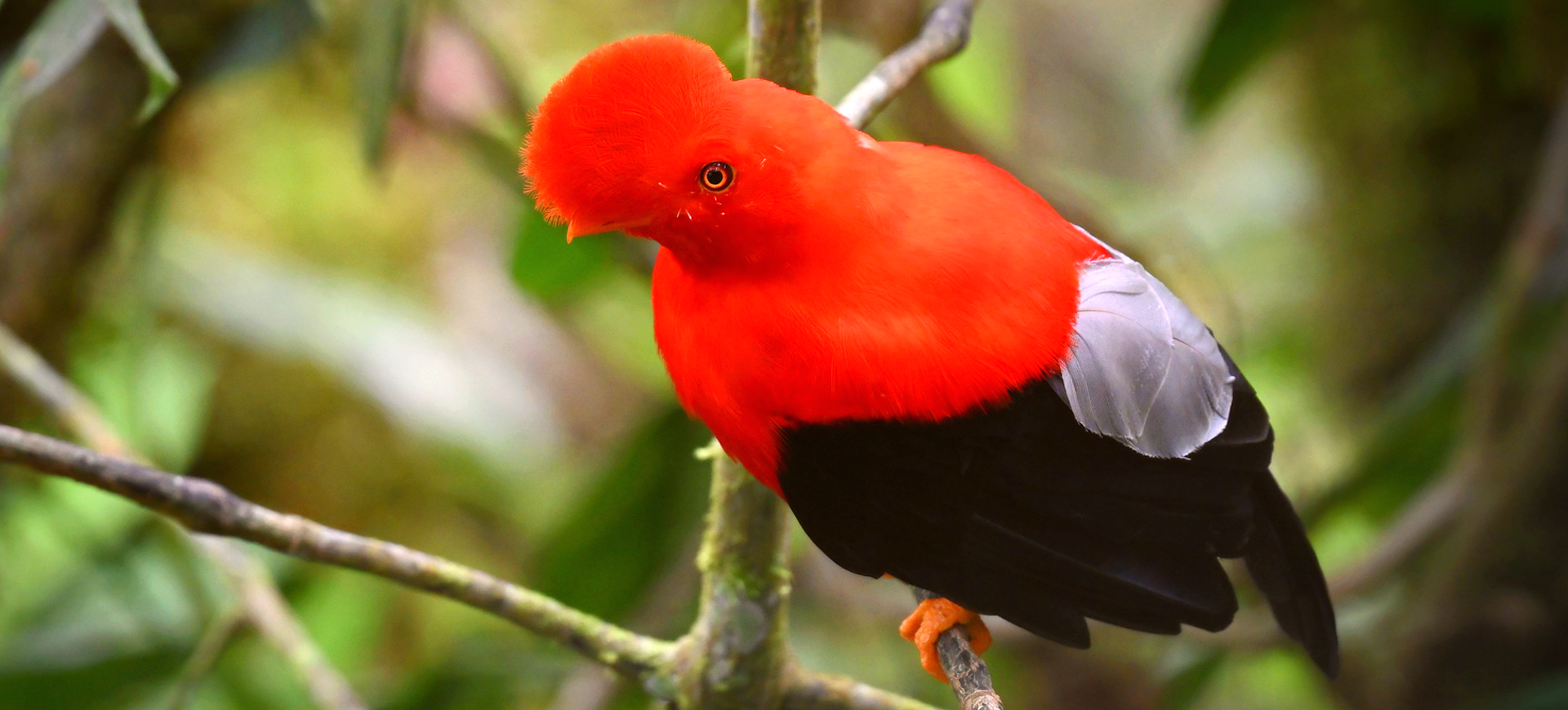Overview
The Guianan Cock-of-the-rock (Rupicola rupicola) is a strikingly vibrant bird native to the rainforests of South America, particularly in the Guiana Shield region. Recognized by its bright orange plumage, the male species is particularly notable for its prominent disk-like crest covering the beak, making it one of the most visually striking birds in its habitat. Females, in contrast, are colored a more subdued orange-brown and lack the dramatic crest, showcasing a significant sexual dimorphism between genders. These birds are primarily frugivorous, feeding on fruits in their rainforest homes, supplemented by insects and small invertebrates.
Guianan Cock-of-the-rocks are known for their unique mating rituals, where males gather in leks to perform elaborate displays and vocalizations to attract females. This behavior highlights their social complexity and importance in the ecosystem as indicators of healthy, undisturbed rainforest environments. They are mostly passive, rarely venturing far from their preferred habitat, which includes rocky outcrops and caves within the dense rainforest where they roost and nest.
Conservation efforts for the Guianan Cock-of-the-rock focus on preserving their rainforest habitat, which faces threats from deforestation, mining, and agriculture. Their reliance on specific habitat types makes them particularly susceptible to environmental changes, emphasizing the need for comprehensive conservation strategies that protect the bird and its ecosystem. The beauty and unique behavior of the Guianan Cock-of-the-rock make it a species of interest for both conservationists and bird enthusiasts worldwide.
Taxonomy
Kingdom
Phylum
Class
Order
Family
Genus
Species
Type
Physical Description:
The Guianan Cock-of-the-rock stands out for its remarkable coloration, with males showcasing a luminous orange-red plumage that easily distinguishes them in their natural habitat. This vivid coloration, coupled with the large, semicircular crest that extends over the beak, makes the males one of the most visually striking birds within the dense rainforests they inhabit. Their robust bodies are perfectly adapted to the dense underbrush of the forest, possessing strong legs and wings designed for agility rather than distance, enabling them to easily navigate the complex foliage. This adaptation is crucial for survival, allowing them to evade predators and efficiently forage in their lush, vegetative environment.
In contrast, female Guianan Cock-of-the-rocks are less conspicuous, adorned in a more subdued palette of orange and brown tones that offer camouflage among the forest’s understory. Their crests are significantly smaller and less pronounced than their male counterparts, underscoring the species’ pronounced sexual dimorphism. Despite their differing appearances, both sexes are equipped with a physique that emphasizes their adaptation to a life primarily spent in the lower levels of the rainforest. The dimorphism between males and females extends beyond mere aesthetics, playing a crucial role in mating rituals and the survival strategies of the species within their complex ecosystem.

Lifespan: Wild: ~8 Years || Captivity: ~10 Years

Weight: Male: 8.8-9.2 lbs (4-4.2 kg) || Female: 7.9-8.4 lbs (3.6-3.8 kg)

Length: Male: 11-12 inches (28-30 cm) || Female: 9-10 inches (23-25 cm)

Wingspan: Male & Female: 18-20 inches (46-51 cm)

Top Speed: 25 mph (40 km/h)
Characteristic:
Native Habitat:
The native habitat of the Guianan Cock-of-the-rock is predominantly the tropical rainforests of the Guiana Shield, encompassing parts of Guyana, Suriname, French Guiana, and northern sections of Brazil and Venezuela. These birds prefer areas with dense vegetation, often near rocky outcrops and cliffs, which provide essential sites for nesting and roosting. Their dependence on specific habitat types makes them vulnerable to deforestation and habitat degradation.
These habitats offer a rich biodiversity that supports the diet and breeding habits of the Guianan Cock-of-the-rock. The complex structure of the rainforest, including its understory and canopy layers, provides food and protection from predators. The preservation of these habitats is crucial not only for the survival of the Guianan Cock-of-the-rock but also for the countless other species that share their environment.
Climate Zones:
Biomes:
WWF Biomes:
Biogeographical Realms:
Continents:
Diet:
Diet & Feeding Habits:
Guianan Cock-of-the-rocks are predominantly frugivorous, relying on a diet composed mainly of fruits obtained from the dense understory of their rainforest habitat. Their broad beak is well-suited for this diet, allowing them to crush and consume various fruits. In addition to fruits, these birds occasionally supplement their diet with insects, small invertebrates, and even small vertebrates, which provide them with essential proteins.
Their feeding behavior highlights the importance of a healthy, biodiverse ecosystem. They play a crucial role in seed dispersal, contributing to the regeneration of their rainforest home. The selection of fruits involves a meticulous process, often favoring ripe fruits, which underscores their role in the ecological balance of their habitat. By dispersing seeds throughout their range, they facilitate the growth of new plants, aiding in maintaining their rainforest environment.
Mating Behavior:
Mating Description:
The mating rituals of the Guianan Cock-of-the-rock are among the most elaborate and visually stunning in the avian world. Males gather in communal display sites known as leks, performing intricate dances and vocalizations to attract females. These displays not only showcase the physical vigor and attractiveness of the males but also play a crucial role in female mate selection, influencing genetic diversity within the population.
The construction of the lekking sites and the males’ competitive displays involve a combination of visual, auditory, and even olfactory cues to appeal to prospective mates. Females visit these sites to observe the males before making their selection, often choosing mates based on the quality of their display, the vibrancy of their plumage, and their territory within the lek. After mating, females assume all responsibilities for nest-building, egg incubation, and chick-rearing, underscoring the species’ unique reproductive strategy.
Reproduction Season:
Birth Type:
Pregnancy Duration:
Female Name:
Male Name:
Baby Name:
Social Structure Description:
The Guianan Cock-of-the-rock exhibits a unique social structure centered around lekking behavior, where males congregate to compete for female attention through displays of plumage and vocalization. Outside the breeding season, they tend to be solitary or gather in small groups, often segregating by sex. This social organization reflects the species’ breeding strategy and adaptation to the dense rainforest environment.
The role of females in the species’ social structure is characterized by their solitary nesting and chick-rearing behaviors, highlighting a strong independence. The dynamic social structure of the Guianan Cock-of-the-rock, with its blend of competitive displays and solitary living, underscores the complexity of avian social systems and their adaptation to specific ecological niches.
Groups:
Conservation Status:
Population Trend:
The population of the Guianan Cock-of-the-rock is considered stable in well-protected and undisturbed areas of its range. However, localized threats like deforestation, mining, and illegal pet trade can impact specific populations. Conservation measures focusing on habitat protection and sustainable land use practices are essential for maintaining stable populations.
Research and monitoring are key to understanding population trends and the effectiveness of conservation strategies. Community involvement in conservation efforts, such as ecotourism and education, can also play a significant role in protecting the Guianan Cock-of-the-rock and its habitat. Fostering a connection between local communities and conserving their natural heritage can achieve long-term sustainability.
Population Threats:
The primary threats to the Guianan Cock-of-the-rock include habitat loss and fragmentation due to deforestation, mining, and agriculture. These activities reduce the available habitat and isolate populations, making it difficult for individuals to find mates and leading to genetic bottlenecks. Additionally, the illegal pet trade poses a significant risk, with their striking appearance making them a target for capture.
Efforts to mitigate these threats involve a combination of protected area management, sustainable land-use practices, and enforcement of laws against illegal wildlife trade. Conservation strategies must be adaptive and inclusive of local communities to ensure the long-term protection of the Guianan Cock-of-the-rock and its rainforest habitat.
Conservation Efforts:
Conservation efforts for the Guianan Cock-of-the-rock focus on habitat protection and establishing protected areas within its range. International collaboration between countries in the Guiana Shield region is essential to create a network of protected habitats supporting viable populations. Environmental education programs aimed at local communities help raise awareness of the species’ plight and the importance of rainforest conservation.
Research into the species’ biology, behavior, and ecology is crucial for informed conservation planning. By understanding the specific needs and threats faced by the Guianan Cock-of-the-rock, conservationists can develop targeted strategies to ensure its survival. Efforts to combat illegal wildlife trade through enforcement and community engagement are also vital to protect this species from exploitation.
Additional Resources:
Fun Facts
- The Guianan Cock-of-the-rock is the national bird of Guyana.
- Males are responsible for one of the bird world’s most vibrant and elaborate mating displays.
- Females solely undertake the building of the nest, incubating the eggs, and rearing the young.
- Their nests are built on rocky cliffs or cave walls, using mud to create a cup-shaped structure.
- The species plays a vital role in their ecosystem as seed dispersers, aiding forest regeneration.
- Despite their bright coloration, they can be difficult to spot in the dense rainforest.
- They have a distinctive call that can be heard throughout their rainforest habitat.
- The Guianan Cock-of-the-rock’s diet helps control fruit and insect populations in the rainforest.
- Juveniles are less brightly colored, gaining their full, vibrant plumage as they mature.
- Their unique appearance has made them a symbol of tropical biodiversity and conservation efforts.









